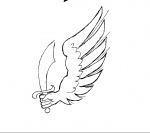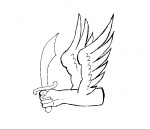Wings that Hold: Difference between revisions
No edit summary |
|||
| Line 26: | Line 26: | ||
{| class="wikitable" | {| class="wikitable" | ||
|+In summary | |+In summary, he difference between these three charges can be seen in the illustrations provided by Bruce Draconarius of Mistholme. | ||
|- | |- | ||
|Wings-that-hold that follow the pattern of the Calabria arms will be blazoned as ''a wing terminating in a hand''. This is the standard depiction found in German heraldry. | |Wings-that-hold that follow the pattern of the Calabria arms will be blazoned as ''a wing terminating in a hand''. This is the standard depiction found in German heraldry. | ||
Revision as of 12:17, 26 August 2018
WARNING: Do not cite this page as a reference. This page is on this wikispace only to make the content "searchable" and easier to find. If you find the information you seek here, go to the original sources as linked below to verify the information and use them for your documentation.
Revised Dec 1, 2013 9:52 am.
See also Wing.
From the August 2005 LoAR Cover Letter:
http://heraldry.sca.org/loar/2005/08/05-08cl.html
From Wreath: Wings That Hold
The SCA has three different kinds of wings-that-hold; they all have a period justification, but they're not the same. We have not been consistent in blazoning these three different charges.
In German heraldry there's a charge termed the Adlerflügel mit Schwerthand ("eagle's wing with sword-hand"). It's a period charge, found in Konrad Grünenberg's Wappenbuch of 1483 (reproduced in Fox-Davies's The Art of Heraldry, 1904, fig.402), and in the Concilium zu Constanz of 1413, f.xcix, in both cases as the arms of the Duke of Calabria. It consists of a single eagle's wing, shown as though couped at the "shoulder" from an eagle displayed: the limb is roughly fesswise, with the feathers spread downward. The sinister end of the wing shows as a bulge; the dexter end of the wing terminates in a hand wielding a sword fesswise reversed above the wing.
Though it's hard to be sure (the German depiction of single wings are very nearly symmetric), the emblazon in the Concilium makes clear that this is a dexter wing. The "bulge" at the sinister end is almost a trefoil, which is how German heraldic art depicts the truncated end of a limb.
Many SCA registrations follow this exemplar. They are usually blazoned along the lines of a wing (sometimes explicitly fesswise) terminating in a hand maintaining a sword fesswise reversed.
A second sort of "wing-with-a-hand" is found in the Armorial de Gelre, c.1370, f.62vo, as a quartering of the arms of the Marques of Villena. The Armorial blazons the charge as a bras ailé ("winged arm"). Here the wing is erect -- essentially bendwise sinister -- but unlike the example of Calabria, the truncated portion of the wing is conjoined to the hand, instead of being at the opposite end of the wing. In Villena's emblazon the hand is in dexter base and the sword palewise.
Both Calabria's variant and Villena's variant have the hand to dexter -- but because of how they're formed, Calabria requires a dexter wing, while Villena requires a sinister wing.
A somewhat larger number of SCA registrations follow this second exemplar (often with a claw substituting for the hand). This variant gets blazoned in a lot of ways, but a hand issuant from a wing or a wing with a hand issuant is common. Because this variant uses a wing of the opposite handedness from the Flügel mit Schwerthand, it requires its own distinct blazon.
Finally, there are a few cases that are, literally, winged hands or claws: a wing (or pair of wings) grafted onto a hand/claw. In these cases, unlike the two previous variants, the hand is usually a significantly large part of the design. Like the second variant above, if the hand is to dexter, then the wing must be a sinister wing. This is both blazonable and acceptable style, but we need to make the distinction. They tend to be blazoned either as winged hands/claws or hands/claws conjoined to a wing.
| Wings-that-hold that follow the pattern of the Calabria arms will be blazoned as a wing terminating in a hand. This is the standard depiction found in German heraldry. | |
| Wings-that-hold that follow the pattern of the Villena arms will be blazoned as a hand issuant from a wing or a wing with a hand issuant | |
| Winged hands or claws will be blazoned as winged hands/claws or hands/claws conjoined to a wing. |


